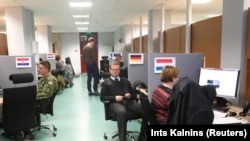Russian Defense Minister Sergei Shoigu follows up the Helsinki summit between the U.S. and Russian presidents with the expressed hope for more military cooperation with NATO. Yet in the TASS Russian state news agency article, Shoigu raises the issues of "intense" military preparations by European neighbors.
In that context, he speaks of the cyber operations centers, some which were established with U.S. assistance. Here is a rundown of the most important cyber defense operations -- established, in some instances, in response to Russian or perceived Russian threats.
In Finland, the Computer Emergency Response Team (CERT-FI), according to official information, appeared in 2002 under the Finnish Communications Regulatory Authority (FICORA). It, like all similar CERT groups in Europe and the world (including, by the way, Russia itself), was really created “with the help of the United States” --to be exact - on the model developed at the American Carnegie Mellon University for organizing the fight against computer viruses, as reported on the official website of the European Union Agency for Network and Information Security (ENISA), established in 2004
And within the framework of the Computer Security Strategy adopted in Finland in 2013, CERT-FI in January 2014 became part of the newly-established National Cyber Security Center Finland (NCSC-FI), also under FICORA.
In addition, the C5 Agency (Command, Control, Communications, Computers and Cyber) has existed at least since 2012 under Finland’s Defense Ministry), one of the tasks of which is to confront cyber threats.
Most likely, in this case, Sergei Shoigu is referring to the European Center of Excellence for Countering Hybrid Threats, opened jointly by the European Union (EU) and NATO in Helsinki last year. A description of the mission of this center, which is actually implied in its name, can be found on the official website of the European External Action Service , the diplomatic service and foreign and defense ministry of the European Union.
In Estonia, there is the NATO Cooperative Cyber Defense Center of Excellence (CCDCOE), which was opened in 2008 following a large-scale cyberattack on Estonia’s infrastructure, which took place after a Soviet-era war memorial was moved from the center of Tallinn to a military cemetery.
At the beginning of 2017, as reported on the website of Estonia’s national radio broadcaster, the government decided to create a cyber command within the country’s armed forces. According to Reuters, it should be fully staffed by 2020, and its resources will include not only computer defense, but also computer counter-actions. Last November, Reuters notes, the largest cyber training exercises in NATO history were held in Estonia hosted the largest in the history of NATO cyber-training, to practice actions in cases of hacker attacks supported by foreign governments.
A Ministry of Digitization has existed in Poland since December 2015. A cybersecurity department has been established inside it, as a CCDCOE document shows, although as of the end of last year it still did not have a director.
The same CCDCOE document notes that a Computer Emergency Response Team (CERT) has been set up under Poland’s Defense Ministry to protect military computer networks. In 2010, National Cybersecurity Center was also established under the Defense Ministry. In 2015, it was dissolved and replaced by a cyber operations center.
In 2016, within the framework of public-private partnership in the country, the National Cybersecurity Center (NC Cyber) was established to protect telecommunications and energy companies and banks from cyberattacks. According to its center, the center had to deal with 1,926 cyberattacks that same year.
In October 2017, Poland’s Defense Minister announced plans to create within his ministry a special unit of cyber troops numbering at least 1,000 people. According to the minister, it was created “in response to corresponding actions of Russia.”
In Germany, the Federal Office for Information Security (BSI), established in 1991, was one of the first such structures in the world. By the beginning of 2017, according to the newspaper Die Zeit, it employed 660 people, but six months later the recruitment of another 180 employees was announced.
In early 2017, Germany announced the creation of a military cyber command called the Cyber and Information Space Command (Kdo CIR), to be manned by 13,500 people. It became the sixth service within the Bundeswehr - along with the army, navy, air force, military medical service and joint support forces. According to Reuters, Germany’s security services report that the number of cyberattacks by Russia on German political parties is increasing. Russia denies this.
In France, the Government Center for Monitoring, Alerting and Responding to Computer Attacks (CERT-FR) has existed since 2000. In 2009, France also created the National Agency for Information Systems Security (ANSSI).
In December 2016, after Russia's interference in the U.S. presidential election, the French army created a Cyber Defense Command (COMCYBER) to prevent a repetition of the same scenario in France, as well as to protect key French infrastructure from hacker attacks from abroad. According to Reuters, some one billion euros will be invested in this command up to 2019, by which time it will be staffed by 3,200 “cyber troops” backed by 4,400 reservists.
In July, members of France’s cyber command marched in Paris’s Bastille Day Parade for the first time.
Regarding NATO, Shoigu points to particular concern about NATO involvement in Finland and Sweden, though there have been reports of Russian airspace violations.
NATO says it attempted to establish a cooperative relationship with Russia over two decades, after the Soviet Union dissolved. The alliance and Russia signed the Founding Act on Mutual Relations, Cooperation and Security in 1997, but that "practical cooperation" ended following Russia's "aggressive" actions in Ukraine. That year, Russia invaded Crimea and annexed it and fomented a conflict that continues in the Donbass region.
Adapted from Factograph.info.









